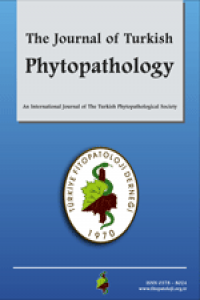Toprak Kökenli Şeker Pancarı Virüsleri ve Vektör Polymyxa Betae Keskin'in Şeker Pancarında Simptom Oluşumu ve Kök Ağırlığı Üzerine Etkileri
Öz
-
Anahtar Kelimeler
The effects of Soilborne Sugar Beet Viruses and Their Vector Polymyxa betae Keskin on Symptom Expression and Root Weight of Sugar Beet
Öz
Sugar beet bait plants grown in soil samples collected in central and northern parts of Turkey were previously found to be infected with Beet necrotic yellow vein virus (BNYVV) and Beet soilborne virus (BSBV) through enzyme-linked immunosorbent assay (ELISA), and with Polymyxa betae using direct coloration method of bait plant root tissues. The effects of BNYVV, BSBV and P. betae, alone and in combination on the growth of sugar beet seedlings were investigated by considering root weight and the mean ELISA values. The result from the statistical analysis showed that total fresh root weight was negatively correlated with BNYVV, BSBV and BNYVV+BSBV infections, but not with aviruliferous P. betae infection. Additionally, the most common symptom after six weeks growing periods was chlorosis for single BNYVV (46%), BSBV (28.1%) and double BNYVV and BSBV (58.5%) infections. Also, the number of plants with no visible symptoms in single BSBV infections (60.3%) was higher than that obtained in single BNYVV infections (39.5%). Most of plants (65.3%) infected with aviruliferous P. betae populations had no visible symptom, however, 24.7% of the plants showed chlorosis. This study indicated that various populations of both sugar beet viruses and P. betae could be present in the region, and BNYVV seems to provoke chlorosis in both single and double infections
Anahtar Kelimeler
Ayrıntılar
| Birincil Dil | Türkçe |
|---|---|
| Bölüm | Makaleler |
| Yazarlar | |
| Yayımlanma Tarihi | 1 Haziran 2007 |
| Yayımlandığı Sayı | Yıl 2007 Cilt: 36 Sayı: 1-2-3 |


